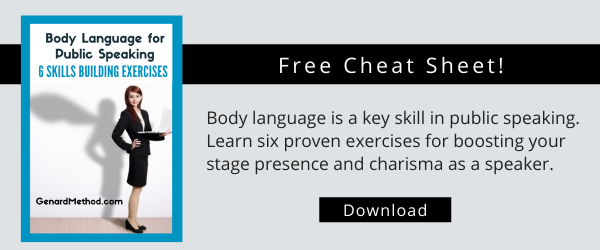Or at least, what you don't say through words. If you have speech anxiety or other forms of stage fright, this is information you certainly need to know.
Studies and anecdotal evidence both support the view that audience members perceive you and judge your competence according to what you show them, in addition to what you say. Many times, your visual behavior is in fact more important to your success than your verbal content. (To get people to respond to you more positively, download my free cheat sheet, " 5 Secrets of Powerful Body Language.")
Body Language Hits and Misses
Concerning "body language in action," think about perceptions people have had over the years to some positive and negative nonverbal communication (body and voice). Consider how these examples have affected our view of the performer:
- Richard Nixon's sweaty persona in the first Kennedy-Nixon debate.
- Mark Zuckerberg's deer-in-the-headlights expression and frequent vocal fillers in early interviews.
- Brandi Chastain clenching fists in triumph with her jersey off (and her sports bra in view) during a 1999 Women's World Cup final with China.
- Elvis Presley's famous hip-swivels that drove 1950s girls and their parents crazy (for different reasons).
- Barack Obama's weak body language in this year's first presidential debate.
Your Own Ability to Appear Strong and Confident
So how can you become a dynamic speaker who compels an audience’s attention through the physical choices you make? Equally important, can you use body language to actually bolster your self-confidence and effectiveness as a speaker?
Clearly, you must exhibit confidence and a sense of authority for audiences to respond to you positively. For one thing, you'll want to avoid the 5 body language errors that will sink your presentation. By standing and moving well, you'll start a positive feedback loop. Audience members will show you their belief in your abilities, you'll feel more confident, and you'll show it in turn.
One of the most important ways you can do so is by a strong stance and the ability to command the space around you. You must, in other words, become aware of the body language image you're broadcasting. By doing so, you'll be exhibiting physical presence. It begins with something as simple as your posture. Think of it this way:
How you stand affects your standing with your audience.
Try this simple exercise:
Stand in front of a half- or full-length mirror. If your posture (your “standing!”) needs to improve—if you slouch with shoulders hunched or lean backward putting too much pressure on your lower back—here’s a visualization that can help: Imagine there’s a string leading upward from the top of your head into infinity.
Someone up there is gently and steadily pulling on that string, causing you to slowly straighten your posture. Gradually, your hips, waist, shoulders, neck, and head each fall into their natural alignment. Your posture is now straight but not stiff.
Here’s an alternate version: Stand with your back against a wall, with your head, backside, and heels all touching the wall. Take a small step forward then relax slightly. Your posture will be much improved though, once again, not stiff or rigid.
"Grounding" for Public Speaking Confidence
Perhaps the most important visualization you can use to improve your public speaking confidence is known as "grounding." It too can help improve your posture. But it does something much more powerful as well: It brings you closer to the commanding physical presence discussed above. The technique is a fundamental tool of performance that comes to you straight from the world of the actor.
Actors understand that part of their power in performance comes from the earth, or in the modern theater, the stage floor. In the earliest forms of Western theater in ancient Greece, actors performed outside on the ground itself. Visualize a ballet dancer’s leap upward and you’ll understand where the power for all forms of in-person performance originates: from the earth under one’s feet.
When you ground yourself as a speaker, you acquire the same power and connection to the earth as those ancient tragedians and comedians. The steadfastness and sense of purpose you then display is instantly noticeable to your audience.
Body language is an amazing tool for engaging, persuasing, and inspiring audiences. For great tips on using nonverbal communication effectively, see my e-book Body Language to Look and Feel Confident.
Here are the two steps to acquire unwavering physical presence as a presenter through grounding:
- Plant your feet firmly on the floor, armpit width apart. And “plant” is a perfect word to use here! Imagine that you’re a 300-year-old oak tree with roots that go deep and wide into the earth. Like that tree you are firm, secure, and unshakeable. Compare your strong stance now with the weak stances some speakers use, with their legs crossed, leaning on one hip, or even standing with their feet touching (what I call the “good boy” or “good girl” stance you used when reciting in front of the class in elementary school). Challenges or harsh questions from the audience might just blow those speakers over!
- Try these competing stances now: Your stable, grounded, “oak-tree” position with feet at armpit width, and then crossing your legs at the ankles. Which one gives you more of a sense of strength and purpose? Now try placing your feet close together, as though you’re a toy tin soldier. You can hardly stand like that without feeling you're in a weak position! And yet speakers do so all the time out of nervousness and uncertainty over what to do with their own bodies.
Added Benefits to Grounding
Another benefit when you ground yourself is that your self-image grows in strength. You simply feel more confident and prepared when you’re standing this way—like you’re holding your ground! Get in this habit, and soon other physical expressions of your confidence will begin to emerge. It’s a self-regulating cycle, helping to give you physically expressed strength of character as a presenter.
Combine this deep-rooted sense of presence with diaphragmatic breathing, and you'll look and feel like a person of consequence. Your self-image itself will help lessen your nervousness.
Key takeaways from this blog:
- A huge part of your influence is from what you don't say, but show.
- Some famous instances of body language have helped or hurt public figures.
- Your ability to feel strong and confident depends in part on how you stand.
- In addition, your "standing" with your audience is due in part to posture.
- Ground yourself to gain power and a sense of connection with the earth.



